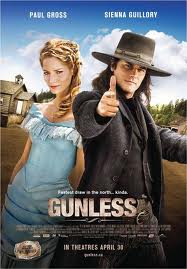 Gunless (2010), a Western comedy shot in Osoyoos and other locations in British Columbia, features Canadian actor Paul Gross, as the gunslinger the Montana Kid, who, fleeing ruthless bounty hunters, accidently crosses the border into Canada where he confronts and is eventually tamed by Canadian Anglo civility and the love of a good Anglo white woman. The Western, like other genres that imagine a fabled past or futures, tends to mark a strategic nostalgia for a past that reflects contemporary anxieties. This film aims to enervate the tired Western plot by situating the film in a Canada peopled with quirky, non violent types, and speak to anxieties about contemporary Canadian national identity in a post national neoliberal era.
Gunless (2010), a Western comedy shot in Osoyoos and other locations in British Columbia, features Canadian actor Paul Gross, as the gunslinger the Montana Kid, who, fleeing ruthless bounty hunters, accidently crosses the border into Canada where he confronts and is eventually tamed by Canadian Anglo civility and the love of a good Anglo white woman. The Western, like other genres that imagine a fabled past or futures, tends to mark a strategic nostalgia for a past that reflects contemporary anxieties. This film aims to enervate the tired Western plot by situating the film in a Canada peopled with quirky, non violent types, and speak to anxieties about contemporary Canadian national identity in a post national neoliberal era.
I first became aware of Paul Gross on the CTV serial Due South (1994-1999) where he played the stiff, upright RCMP constable Brenton Fraser and later in his “auteur” films that he wrote, directed, and played the lead: the curling comedy Men with Brooms (2002), and the epic historical feature Passchendaele (2008). Unlike the Trailer Park Boys and more nebbish contemporary Canadian white male leads like Don McKellar, whose characters and performances seem to adhere to the notion of Canadian males as quirky born losers, Gross has staked out his territory as the hunky, witty Anglo Canadian male lead. Gross aims for a type of Anglo Canadian benevolence where the English white male hero helps racialized Others become part of the Canadian cultural fabric. Men with Brooms, set in small town Canada, is remarkable for its lack of diversity in casting while Passchendaele, a maple leaf homage to Spielberg’s Saving Private Ryan, negotiates race by having Paul Gross’s masculine Anglo character Michael Dunn literally die for the “sins” of two German-Canadians, who can then be integrated into the fabric of the Canadian imaginary. This film endorses militarism as the logical extension of Canadian virile identity. The tortured character of Michael Dunn embodies a notion of Canadian identity wrapped up in a “muscular Christianity” that saves others (Coleman).
On the margins of Passchendaele’s narrative is an aboriginal character with one name called “Highway” who appear briefly on screen despite being Dunn’s good friend. Highway’s absent presence hints that the film is attempting to secure a national imaginary that sees white Canadians as always already post colonial. Highway’s character ensures that viewers see Dunn as a “settler” who has become “native” (Alhuwalia). Thus we do not see Highway asking about land claims or questioning the imperial project of the war, but we do see Dunn’s invader-settler (Bryden) character representing a particular egalitarian form of liberal Canadian democracy. Dunn rejects the British imperial regime and beats up a low class white thug called “Mr. Harper” who stands for explicit racism as Harper and his cronies appear to have painted ethnic slurs on the house belonging to the Dunn’s German-Canadian lover and her brother. This film’s logic is that only the Canadian-born Michael Dunn can secure a benevolent form of Canadian consciousness where white English-speaking Canadian are driven by a “duty to protect” that makes violence necessary. Although set in World War I, this film implicitly and explicitly endorses the occupation of Afghanistan as a brutal necessity that helps maintain Canadian identity as one that embraces military adventures abroad. Dunn’s head butting of the explicitly racist character Mr. Harper is clearly a symbolic jab at the current Harper government’s policies on the Arts and Culture, but again this violence works to suggest Canadian identity is invested in the idea that the nation must use overwhelming force to throw one’s opponents off guard. The simply binary of Harper as a “bad” low class Anglo-Canadian white racist versus Dunn (Gross) as a good liberal Canadian points to a gaping contradiction in Anglo Canadian identity that is unwilling to confront systemic racism and more willing to point to extreme white supremacy as the “bad apple” in the inherently good Canadian system.
